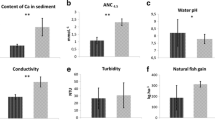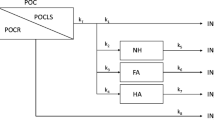Abstract
Water chemistry of the Chascomús Pond (Province of Buenos Aires, Argentina) was studied during a year characterized by low precipitation. Supersaturation of calcium carbonate up to a calcite saturation index of about 20 in spring and summer was observed, together with a diminution of the concentration of dissolved organic matter, in particular humic substances (HS). These results suggested an adsorption between organic matter and calcium carbonate which should influence the growth of calcium carbonate crystals. A preferential removal of higher molecular weight HS was observed by gel permeation chromatography experiments.
Similar content being viewed by others
References
APHA, 1985. Standard Methods for the Examination of Water and Wastes. American Public Health Association. Washington DC, 1268 pp.
Chave, K. E., 1965. Carbonates: Association with Organic Matter in Surface Seawater. Science 148: 1723–1724.
Conzonno, V. H. & A. Fernández Cirelli, 1987. Soluble Humic Substances from the affluents of Chascomús Pond (Argentina). Arch. Hydrobiol. 109: 305–314.
Conzonno, V. H. & A. Fernández Cirelli, 1988. Soluble Humic Substances from Chascomús Pond (Argentina). Factors influencing distribution and dynamics. Arch. Hydrobiol. 111: 467–473.
Conzonno, V. H. & E. F. Claverie, 1987/8. Phytoplankton primary production in Chascomús Pond, (Provincia de Buenos Aires, Argentina). Ecosur 14/15: 7–16.
Conzonno, V. H. & E. F. Claverie, 1990. Chemical characteristics of the water of Chascomús Pond (Provincia de Buenos Aires, Argentina). Limnological implications. Rev. Brasil. Biol. 50: 15–21.
De Haan, H. & T. De Boer, 1986. Geochemical aspects of aqueous iron, phosphorus and dissolved organic carbon in the humic Lake Tjeukemeer, The Netherlands. Freshwat. Biol.: 661–672.
Effler, S. W. & C. T. Driscoll, 1985. Calcium chemistry and deposition in ionically enriched Onondaga Lake, New York. Envir. Sci. Tech. 19: 716–720.
Golterman, H. L., 1971. Methods for chemicals analysis of freshwaters. IBP Handbook N° 8. Blackwell Scientific Publications, Oxford, 583 pp.
Golterman, H. L. & F. A. Kouwe, 1980. Chemical budgets and nutrient pathways. In E. D. le Cren & R. H. McConnell (eds), I.B.P. 22: The functioning of freshwater systems. Cambridge University Press, Cambridge, 788 pp.
Golterman, H. L. & M. L. Meyer, 1985. The geochemistry of two hard water rivers, the Rhine and the Rhone. Part 2. The apparent solubility of Calcium carbonate. Hydrobiologia 126: 11–19.
Jones, R. I., K. Salonen & H. De Haan, 1988. Phosphorus transformation in the epilimnion of humic lakes: abiotic interactions between dissolved humic materials and phosphate. Freshwat. Biol. 19: 357–369.
Küchler-Krischun, J. & J. Kleiner, 1990. Heterogeneously nucleated calcite precipitation in Lake Constance. A short time resolution study. Aquat. Sci. 52/2: 176–197.
Murphy, T. P., K. J. Hall & T. Yesaki, 1983. Coprecipitation of phosphate with calcite in a naturally eutrophic lake. Limnol. Oceanogr. 28: 58–69.
Otsuki, A. & R. G. Wetzel, 1973. Interaction of yellow organic acids with calcium carbonate in freshwater. Limnol. Oceanogr. 18: 490–493.
Otsuki, A. & R. G. Wetzel, 1974. Calcium and total alkalinity budgets and calcium carbonate precipitation of a small hardwater lake. Arch. Hydrobiol. 73: 14–30.
Pantin, H. M., 1965. The effect of adsorption on the attainment of physical and chemical equilibrium in sediments. N.Z.J. Geol. Geophys. 8: 453–464.
Reynolds, R. C., 1978. Polyphenol inhibition of calcite precipitation in Lake Powell. Limnol. Oceanogr. 23: 588–597.
Ringuelet, R. A., A. Salibidn, E. F. Claverie & S. Ilhdro, 1967. Limnología química de las lagunas pampásicas (Provincia de Buenos Aires). Physis 74: 201–221.
Stewart, J. A. & R. G. Wetzel, 1981a. Dissolved humic materials. Photodegradation, sediment effects, and reactivity with phosphate and calcium carbonate precipitation. Arch. Hydrobiol. 92: 265–286.
Stewart, J. A. & R. G. Wetzel, 1981b. Asymmetrical relationships between absorbance, fluorescence and dissolved organic carbon. Limnol. Oceanogr. 26: 590–597.
Stewart, J. A. & R. G. Wetzel, 1982. Influence of dissolved humic materials on carbon assimilation and alkaline phosphatase activity in natural algal-bacterial assemblages. Freshwat. Biol. 12: 369–380.
Stumm, W. & J. J. Morgan, 1970. Aquatic Chemistry. John Wiley & Sons, Inc. New York, 583 pp.
Suess, E., 1970. Interaction of organic compounds with calcium carbonate-I. Association phenomena and geochemical implications. Geochim. Cosmochim. Acta 34: 157–168.
Thomthwaite, C. W., 1948. An approach toward a rational classification of climate. Geograph. Rev. 38: 55–94.
Author information
Authors and Affiliations
Additional information
Contribution N° 524, Instituto de Limnología ‘Dr Raúl A. Ringuelet’.
Rights and permissions
About this article
Cite this article
Conzonno, V.H., Cirelli, A.F. Dissolved organic matter in Chascomús Pond (Argentina). Influence of calcium carbonate on humic acid concentration. Hydrobiologia 297, 55–59 (1995). https://doi.org/10.1007/BF00033501
Received:
Accepted:
Issue Date:
DOI: https://doi.org/10.1007/BF00033501




